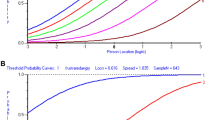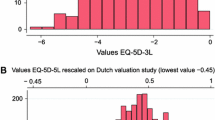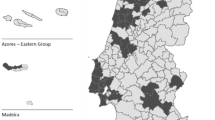Abstract
Background
A new preference-based measure (MacNew-7D) has recently been developed to allow condition-specific data to be used to capture the quality of life in health economic evaluations in cardiology; however, a general population value set has not yet been developed. This study developed a population utility value set for the MacNew-7D heart disease-specific instrument.
Methods
The discrete choice experiments (DCE) technique was chosen as the preference-elicitation method. The DCE asked respondents to compare two options and to state their preferences. The survey was conducted using an online panel of respondents, with quota sampling using age groups, sex and jurisdictions to achieve representativeness of the Australian population. The total design consisted of 200 choice sets, of which each respondent answered eight. Additionally, each respondent answered two quality control choice sets. The best-fitting models were selected on the basis of consistency, parsimony, and goodness of fit.
Results
In total, 1903 respondents were included in the analyses. The MacNew-7D utility value set ranged from −0.4456 to 1.000 for health states defined by the classification system. The best-fitting model retained all levels for five dimensions and collapsed one adjacent level for the other two dimensions. Findings were robust to sensitivity analyses related to the inclusion or exclusion of dominancy and repeat tasks.
Conclusion
Findings indicated that the MacNew-7D utility value set is likely suitable for estimating quality-adjusted life years derived from the MacNew heart disease health-related quality–of-life questionnaire. This value set was derived from an Australian population-based sample and may not be generalisable to dissimilar populations.

Similar content being viewed by others
Data availability
The datasets are not publicly available as publications are planned but are available from the corresponding author upon reasonable request.
References
OECD. Health at a Glance. (2019). OECD Indicators, OECD Publishing, Paris. https://doi.org/10.1787/4dd50c09-en
Australian institute of health and welfare. Cardiovascular disease. Canberra: AIHW; 2020.
Virani, S. S., Alonso, A., Aparicio, H. J., Benjamin, E. J., Bittencourt, M. S., Callaway, C. W., & CarsonChamberlainChengDellingElkind, A. P. A. M. S. F. N. M. S. (2021). Heart disease and stroke statistics-2021 update: A report from the American heart association. Circulation, 143(8), e254–e743.
Australian Bureau of Statistics. Census of Population and Housing (Usual residence data). 2016.
Medical Services Advisory Committee. 1387 - Cardiac Contractility Modulation (OPTIMIZER™ IVs). In: Health Department, Australia 2015.
National Institute for Health and Care Excellence. Sacubitril valsartan for treating symptomatic chronic heart failure with reduced ejection fraction. Technology appraisal. 2016;388(TA388).
Kularatna, S., Byrnes, J., Chan, Y. K., Carrington, M. J., Stewart, S., & Scuffham, P. A. (2017). Comparison of contemporaneous responses for EQ-5D-3L and Minnesota living with heart failure; a case for disease specific multiattribute utility instrument in cardiovascular conditions. International Journal of Cardiology, 227, 172–176.
Kularatna, S., Rowen, D., Mukuria, C., McPhail, S., Chen, G., Mulhern, B., Whitty, J. A., Byrnes, J., Scuffham, P., Atherton, J., & Höfer, S. (2021). Development of a preference-based heart disease-specific health state classification system using MacNew heart disease-related quality of life instrument. Quality of Life Research, 31, 254–268.
Mulhern, B., Norman, R., Street, D. J., & Viney, R. (2019). One method, many methodological choices: A structured review of discrete-choice experiments for health state valuation. PharmacoEconomics, 37(1), 29–43.
Norman, R., Viney, R., Aaronson, N. K., Brazier, J. E., Cella, D., Costa, D. S. J., Fayers, P. M., Kemmler, G., Peacock, S., Pickard, A. S., & Rowen, D. (2016). Using a discrete choice experiment to value the QLU-C10D: Feasibility and sensitivity to presentation format. Quality of Life Research, 25(3), 637–49.
Comans, T. A., Nguyen, K.-H., Ratcliffe, J., Rowen, D., & Mulhern, B. (2020). Valuing the AD-5D dementia utility instrument: An estimation of a general population tariff. PharmacoEconomics, 38(8), 871–881.
Bansback, N., Brazier, J., Tsuchiya, A., & Anis, A. (2012). Using a discrete choice experiment to estimate health state utility values. Journal of Health Economics, 31(1), 306–318.
Bansback, N., Hole, A. R., Mulhern, B., & Tsuchiya, A. (2014). Testing a discrete choice experiment including duration to value health states for large descriptive systems: Addressing design and sampling issues. Social Science and Medicine, 114, 38–48.
Norman, R., Mercieca-Bebber, R., Rowen, D., Brazier, J. E., Cella, D., Pickard, A. S., Street, D. J., Viney, R., Revicki, D., & King, M. T. (2019). UK utility weights for the EORTC QLU-C10D. Health Economics, 28(12), 1385–401.
ChoiceMetrics (2012) Ngene 1.1.1 User Manual & Reference Guide, Australia.
Johnson, F., Lancsar, E., Marshall, D., Kilambi, V., Mühlbacher, A., Regier, D. A., et al. (2013). Constructing experimental designs for discrete-choice experiments: Report of the ISPOR conjoint analysis experimental design good research practices task force. Value Health, 16(1), 3–13.
Jonker, M. F., Donkers, B., de Bekker-Grob, E., & Stolk, E. A. (2019). Attribute level overlap (and color coding) can reduce task complexity, improve choice consistency, and decrease the dropout rate in discrete choice experiments. Health Economics., 28(3), 350–363.
Coast, J., Flynn, T. N., Salisbury, C., Louviere, J., & Peters, T. J. (2006). Maximising responses to discrete choice experiments: A randomised trial. Applied Health Economics and Health Policy, 5(4), 249–260.
Johnson, F. R., Yang, J. C., & Reed, S. D. (2019). The internal validity of discrete choice experiment data: A testing tool for quantitative assessments. Value Health, 22(2), 157–160.
EuroQoL. EQ-5D-5L About Available from: https://euroqol.org/eq-5d-instruments/eq-5d-5l-about/
Hettiarachchi, R., Kularatna, S., Byrnes, J., Mulhern, B., Chen, G., & Scuffham, P. A. (2020). Valuation study for a preference-based quality of life measure for dental caries (dental caries utility index-DCUI) among Australian adolescents-study protocol. British Medical Journal Open, 10(10), e038626.
McFadden, D. (1974). Conditional logit analysis of qualitative choice behavior. In P. Zarembka (Ed.), Frontiers in econometrics (pp. 105–142). Academic Press.
Xie, F., Pickard, A. S., Krabbe, P. F., Revicki, D., Viney, R., Devlin, N., & Feeny, D. (2015). A checklist for reporting valuation studies of multi-attribute utility-based instruments (CREATE). PharmacoEconomics, 33(8), 867–877.
Australian Bureau of Statistics. National, State and territory population. Australia 2021. https://www.abs.gov.au/statistics/people/population/national-state-and-territory-population/latest-release
McCaffrey, N., Kaambwa, B., Currow, D. C., & Ratcliffe, J. (2016). Health-related quality of life measured using the EQ-5D-5L: South Australian population norms. Health and Quality of Life Outcomes, 14(1), 133.
McPhail, S., & Haines, T. (2010). Response shift, recall bias and their effect on measuring change in health-related quality of life amongst older hospital patients. Health and Quality of Life Outcomes, 8, 65.
King, M. T., Viney, R., Simon Pickard, A., Rowen, D., Aaronson, N. K., Brazier, J. E. J. E., Cella, D., Costa, D. S., Fayers, P. M., Kemmler, G., & McTaggart-Cowen, H. (2018). Australian utility weights for the EORTC QLU-C10D, a multi-attribute utility instrument derived from the cancer-specific quality of life questionnaire, EORTC QLQ-C30. Pharmacoeconomics., 36(2), 225–38.
Xie, F., Pullenayegum, E., Gaebel, K., Bansback, N., Bryan, S., Ohinmaa, A., Poissant, L., & Johnson, J. A. (2016). A time trade-off-derived value set of the EQ-5D-5L for Canada. Medical Care, 54(1), 98–105.
Höfer, S., Lim, L., Guyatt, G., & Oldridge, N. (2004). The MacNew heart disease health-related quality of life instrument: A summary. Health and Quality of Life Outcomes, 2, 3.
Kularatna, S., Whitty, J. A., Johnson, N. W., Jayasinghe, R., & Scuffham, P. A. (2015). Valuing EQ-5D health states for Sri Lanka. Quality of Life Research, 24(7), 1785–1793.
Hauber, A. B., González, J. M., Groothuis-Oudshoorn, C. G. M., Prior, T., Marshall, D. A., Cunningham, C., & IJzermanBridges, M. J. J. F. (2016). Statistical methods for the analysis of discrete choice experiments: A report of the ISPOR conjoint analysis good research practices task force. Value in Health, 19(4), 300–315.
Bilbao, A., Escobar, A., García-Perez, L., Navarro, G., & Quirós, R. (2016). The Minnesota living with heart failure questionnaire: Comparison of different factor structures. Health and quality of life outcomes, 14, 23.
Spertus, J. A., Winder, J. A., Dewhurst, T. A., Deyo, R. A., Prodzinski, J., McDonell, M., & Fihn, S. D. (1995). Development and evaluation of the Seattle Angina questionnaire: a new functional status measure for coronary artery disease. Journal of the American College of Cardiology, 25(2), 333–41.
Green, C. P., Porter, C. B., Bresnahan, D. R., & Spertus, J. A. (2000). Development and evaluation of the Kansas City cardiomyopathy questionnaire: A new health status measure for heart failure. Journal of the American College of Cardiology, 35(5), 1245–1255.
Acknowledgements
School of Health and Related Research, The University of Sheffield, hosted Dr. Kularatna and facilitated the exchange of ideas between academic groups.
Funding
This study was funded by an Australian Heart Foundation Vanguard grant (2016/101407) and Heart Foundation post-doctoral fellowship for Dr. Kularatna. Centre for Healthcare Transformation, Queensland University of Technology, funded the DCE data collection. SMM is supported by an NHMRC administered fellowship #1161138.
Author information
Authors and Affiliations
Contributions
SK developed the idea, conducted the analysis and wrote the first draft of the paper. GC, RN, CM, DR and BM contributed to the plan of data collection, DCE design and contributed to the writing of the manuscript. SS, RH and KF did the data collection, assisted the data analysis and contributed to the manuscript. WP and SM assisted in developing the idea, data collection and writing the manuscript. All authors read and approved the final manuscript.
Corresponding author
Ethics declarations
Competing interests
The authors have no relevant financial or non-financial interests to disclose.
Ethical approval
This study received ethical approval from the Queensland University of Technology Human Research Ethics Committee (Reference No. #2000000573).
Consent to participate
Survey respondents were sourced from an existing Australian online panel administered by Pureprofile (www.pureprofile.com). This panel was drawn from volunteers (aged 18 and above, be able to give consent and understand English) in the general population who were paid a small amount by the panel administrators for completion of the survey.
Additional information
Publisher's Note
Springer Nature remains neutral with regard to jurisdictional claims in published maps and institutional affiliations.
Supplementary Information
Below is the link to the electronic supplementary material.
Rights and permissions
Springer Nature or its licensor (e.g. a society or other partner) holds exclusive rights to this article under a publishing agreement with the author(s) or other rightsholder(s); author self-archiving of the accepted manuscript version of this article is solely governed by the terms of such publishing agreement and applicable law.
About this article
Cite this article
Kularatna, S., Chen, G., Norman, R. et al. Developing an Australian utility value set for MacNew-7D health states. Qual Life Res 32, 1151–1163 (2023). https://doi.org/10.1007/s11136-022-03325-6
Accepted:
Published:
Issue Date:
DOI: https://doi.org/10.1007/s11136-022-03325-6




